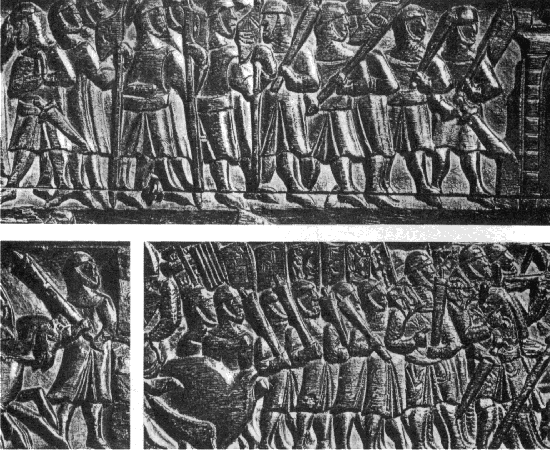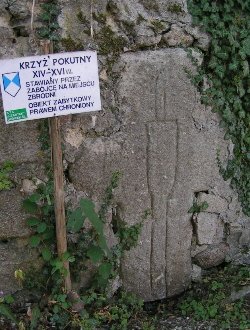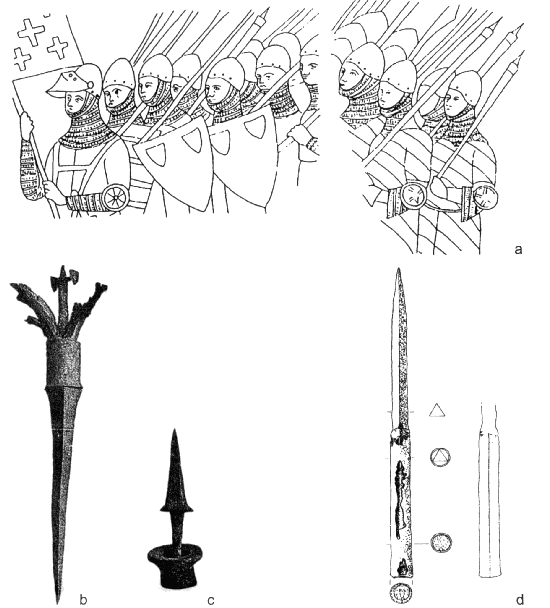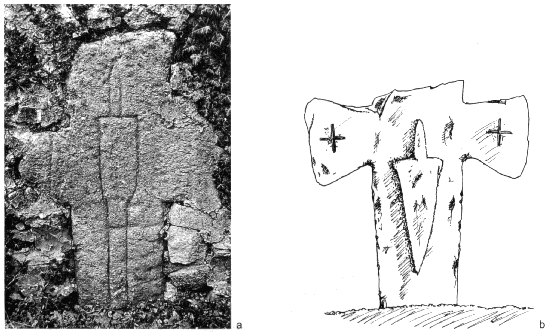
Fig.1. Carved panels of the so-called Oxford ehest depicting the Battle of Courtrai, first quarter of the fourteenth Century (after Ffoulks 1914)



PLZ:
GPS:
Standort:
Das Dorf Neuland liegt etwa 5km westlich von der Stadt Löwenberg (Lwówek Śląski), das lateinische Kreuz ist in die Kirchhofsmauer der Kirche św. Jadwigi (St. Hedwig) bündig eingemauert.Größe / Material:
90:63:?Geschichte:
Die Einzeichnung auf dem Steinkreuz stellt ein "Goedendag" dar, eine mittelalterliche Waffe flämischen Ursprungs.Sage:
Quellen und Literatur:
During the conflict between King Edward I and the Iron King - Philip IV the Fair, the Flemish went to war on the English side.
Consequently, Guy of Dampierre was taken prisoner and a large invasion army was left by the French ruler in the territory of his previous military activity. Any attempts at
interference in the internal affairs of Flanders, particularly the presence of foreign forces commanded by Deputy J. de St Pol, were considered by free Flemish cities as a
violation of their political rights and a threat to their independence. The growing disapproval of the French authorities, which became especially evident when new taxes
were levied on Flemish people2), made Philip IV the Fair enter into negotiations with city representatives in Brügge, the most
radical centre ofresistance, onMay 17, 1302.
On entering the city, the French forces began to repress and persecute the inhabitants. The grave news reached the Flemish rebels staying
outside the city walls. On May 18, just before dawn, when most of the enemy army were fast asleep, the Flemish attacked the enemy killing about 300 French soldiers3).
Every person who failed to pronounce the expression 'Schilt en Vriendt!' properly was mercilessly slaughtered4). This incident
constituted a prelude to an armed conflict, which ended in a shattering defeat of the French knighthood at the walls of Courtrai Castle on July 11, 1302. French
Commander Count Robert D'Artois himself begged for mercy in vain and was killed.
The news of the first glorious victory won by the Flemish army, which was mostly composed of plebeian infantrymen, over the experienced
and well-trained knights5) quickly spread across con-temporary Europe. The number of knights fighting on the Flemish side
is estimated at 500. Those warriors, however, were dismounted and joined the ranks of common foot soldiers6). The
encounter was called the Battle of the Golden Spurs, because the wounded French soldiers ruthlessly maimed and killed by the Flemish, were robbed of their
tournament trophies - the golden spurs. The victors collected a large number of such items from the battlefield.
There are numerous reliable historical records providing Information about the Flemish-French wars, including the poem Branche des
royaux lignages composed by Guillaum Guiart, who served in the army led by Philip IV the Fair as a crossbowman and fought in the Battle of Mons en Pevele in
1304 himself7). It is also known that the last meal eaten by the Flemish before the combat consisted of fish, eggs, sorrel
and mustard8).
From the Student's of arms point of view, the archaeological finds, weapons and pieces of art related to the battle, are of paramount
importance. The so-called Oxford ehest made of oak wood is probably the most famous example of this sort of evidence9).
 |
Fig.1. Carved panels of the so-called Oxford ehest depicting the Battle of Courtrai, first quarter of the fourteenth Century (after Ffoulks 1914) |
 |
Fig.2. Goedendags: a - wall paintings in the former St John's hospital in Ghent, mid- fourteenth Century (after Nicolle 1999a); b, c - archeological finds from Termonde, Belgium (after Moens 1900); d - find from Hammerberg, near Dillenburg-Niederscheld, Kr. Lahn-Dill, Hessen (after Striffler 1998). |
 |
Fig.3: a - stone cross, St Hedwig's Church at Niwnice, Lwówek Śląski powiat (county). Photo by D. Wojtucki; b - stone cross, the collection of lapidary art in Carcassone Castle. Drawing by R. Hes. |
(Fasciculi Archaeologiae Historice Fasc. XX, S.83-90, PL ISSN 0860-0007)Anmerkungen:
1) The present paper is a part of L. Marek's doctoral the-sis with the title Broń biała piechoty na Śląsku od XIV do XVIwieku (Infantry Side Arms in Silesiafrom the Fourteenth to the Sixteenth Century); D. Wojtucki is the author of numerous important contributions to this paper, particularly the section dealing with stone crosses, and to the discussion of some of the historical records.
2) B. Zientara, Świt narodów europejskich {The Dawn ofthe European Nations), Warszawa 1985, p.325.
3) K. de Vries, Infantry Warfare in the Fourteenth Century, Woodbridge 2000, p.9.
4) B. Zientara, op. cit., 1985, p.326.
5) J. Wimmer, Historia piechoty polskiej do roku 1864 (A History ofthe Polish Infantry to 1864), Warszawa 1978, p.32.
6) K. de Vries, op. cit., p.13.
7) Ibidem, p.33.
8) Ch. Ffoulkes, A Carved Flemish Chest at New College, Oxford, Archeologia, 1914, vol. 65, p.116.
9) E. Oakeshott, European Weapons and Armour, Boydell Press, Woodbridge, 2000, p.56.
10) Ch. Ffoulkes, op. cit., p.113.
11) Ibidem, p.118.
12) Ibidem, p.125.
13) Ibidem, pp.122-123.
14 ) The Flemish arrived in Courtrai on June 26th and erected a System of earthen obstacles meant to weaken the impact of the attacking cavalry thus adopting a defensive tactic.
15) Ch. Ffoulkes, op. cit., p.124.
16) K. de Vries, op. cit., pp.12-13.
17) Ch. Foulkes, op. cit., p.121.
18) J-Th. Raadt, Étudie critique [in:] Nouveau catalogue le muse de la Porte de Hal á Bruxelles, 1897, p.32.
19) D. Nicole, Arms and Armour of the Crusading Era, Western Europe and Crusader States, London, p.200.
20) J-Th. Raadt, op. cit., p.32.
21) J. van Malderghem, La verte sur le goedendag, Annales de la Sociéte d'Archeologie de Bruxelles, 1895, vol.9, p.323.
22) J-Th. Raadt, op. cit., fig.8.
23) Ibidem, p.33.
24) Ibidem, p.33.
25) Ch. Buttin, La Fourche de guerre (XV). Le Plançon á picot et le plançon á brocke ou chandelier (XVI). Le Goedendag (XVII), "Bulletin de la Sociéte des Amis du Musee de A'Armée", vol. 49, December 1938, p.201 (The authors would like to thank Annette Saemann for permis-sion to use this publication).
26) C. Blair, European & American Arms, New York, 1962, p.25.
27) Ch. Buttin, op. cit., pp.203, 208.
28) Ibidem, p.29.
29) H. Seitz, Blankwaffen I, Braunschwig, 1965, pp.240-241.
30) Ibidem, p.401, fig.307.
31) G. C. Stone, 1999 (1935), A Glossary of the Construction, Decoration and Use of Arms and Armour, New York, p.248.
32) E. Oakeshott, op. cit., p.45.
33) Ibidem, p.56.
34) J. Moens, Goedendag et plançon á picot. D'aprés Guilliaume Guiart, "Annales de la Sociéte d'Archeologie de Bruxelles", 1900 vol.14, p.5; Ch. Ffoulkes, op. cit., p.120.
35) J. Moens, op. cit., p.7.
36) Ibidem, p.7.
37) G. Striffler, Dillenburgh-Niederschled, (Lahn-Dill-Kreis), Fundberichte aus Hessen, 1998 yearbook 26, p.502.
38) Ibidem, p.502, fig.215.4.
39) J. Moens, op. cit., p.8.
40) Ch. Butwin, op. cit., p.184.
41) K. de Vries, op. cit., pp.12-13.
42) D. Nicole, op. cit., p.84, fig.219.
43) Ibidem, p.198, fig.534.d.
44) R Nocuri, Zabytki jurysdykcji karnej w późnośredniowiecznym i wczesnonowożytnym Wrocławiu w ujęciu archeologii historycznej (Surviving Penal Jurisdiction Specimens in Late Medieval and Early Postmedieval Wroclaw. A Historical Archeological Approach) [in:] J. Piekalski, K. Wachowski ed., Wrocław na przełomie średniowiecza i czasów nowożytnych. Materialne przejawy życia codziennego (Wrocław at the End ofthe Middle Ages and the Beginning of Postmedieval Times. The Material Manifestations of Everyday Life), Wrocław 2004, p.31.
45) Item Cuncendorf LVII mansi posili ... ecclesia ..., T. Kozaczewski, Wiejskie kościoły parafialne XIII wieku na Śląsku (miejscowości A-G), [VülageParochial Churches in Silesia in the Thirteenth Century (Villages A-G)], Wrocław 1995, p.18.
46) A. Scheer,Krzyże pokutne koło Lwówka Śl. (Penance Crosses near Lwówek Śl.), "Przydrożne Pomniki Przeszłości", December 1986, p.6.
47) Das Spätmittelalteriche Steinkreuz eines Holzfällers / Holzhauers / Zimmermanns bei Hesselbach, Gemeinde Hesseneck im Odenwaldkreis, um 1500, Der Odenwald, 2005, p.66.
48) B. Zientara, Henryk Brodaty i jego czasy {Henry the Bearded and his Times), Warszawa 1975, p.179.
49) F. Schelling, Ursprung und Frühzeit des Deutschtums in Schlesien und Land Leubus, Leipzig 1938.
50) Ibidem, p.50.
51) B. Zientara, Walonowie na Śląsku w XII i XIII w. (Walloon People in Silesia in the Twelfth and Thirteenth Centuries), Przegląd Historyczny, 1975a, vol.66, fascicle 3, pp.353, 356.
52) Ibidem, p.353.
53) Rechnungen der Stadt Breslau von 1299-1358, hrgb. C. Grünhagen, Codex Diplomaticus Silesiae, Bd.3, Breslau 1860, pp.9-10 and 23.
54) B. Zientara, 1975, op. cit., p.131.
55) B. Zientara, 1975a, op. cit., p.360.
56) It is alleged that after the Battle of Courtrai, the Flemish were so proud of themselves for defeating the enemy that one Flemish warrior armed with a goedendag would duel two French mounted soldiers (cf: De Vries 2000, p.10).
57) D. Adamska, P. Nocuń, "CZU TROSTE UND CZU HULFFE DES ZELE". Późnośredniowieczne ugody kompozycyjne z terenu Śląska ("CZU TROSTE UND CZU HULFFE DES ZELE". Late Medieval Compositio Agreements from Silesian Territory), "Sobótka", No.2, 2004, pp.111-112.
58) R. Heś, D. Wojtucki, 700 lat najstarszego krzyża pojednania na Śląsku (700 Years ofthe Oldest Reconciliation Cross in Silesia), "Sudety", No.12, 2005, p.14.
59) M. Hellmich, Steinerne Zeugen mittelalterlichen Rechtes in Schlesien. Steinkreuze, Bildstöcke, Staupsäulen, Galgen, Gerichtstische, Liegnitz 1923, pp.13-15.
60) B. Zientara, 1975, op. cit., pp.131, 174, 192.
61) B. Zientara, 1975a, op. cit., p.356.
62) Ch. Ffoulkes, 1914, op. cit., p.122.
63) Cf.: www.imareal.oeaw.ac.at
 |